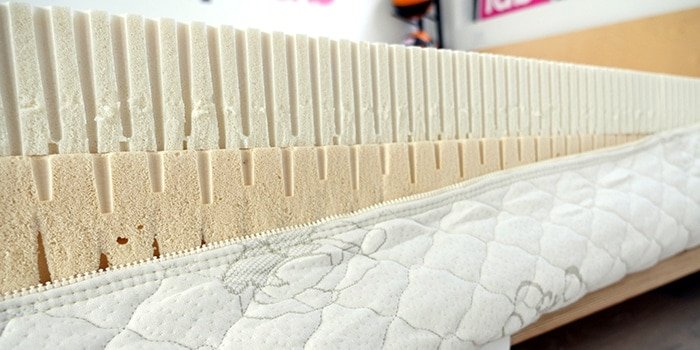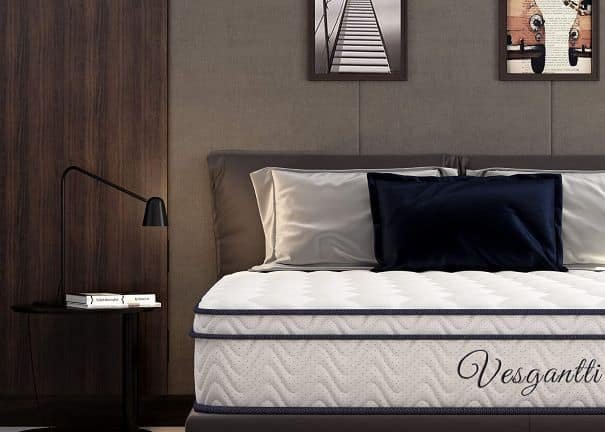How Long Do Natural Latex Mattresses Last? A Comprehensive Durability Guide
Natural latex mattresses are famous for their comfort, durability, and eco-friendliness. These mattresses are made from the sap of the rubber tree, which is transformed into a foam material with unique properties. As people become more aware of the environmental impact of their purchasing choices, the demand for eco-friendly products like natural latex mattresses is rising.
One of the critical factors when considering a new mattress is its lifespan. A mattress is an investment, and consumers want to know how long they can expect their purchase to last. Natural latex mattresses are among the most durable on the market, with some lasting up to 20 years or more. However, the exact lifespan can vary depending on factors such as the type of latex used, manufacturing processes, and proper care and maintenance. Please read our guide on the best 5 latex mattresses available right now!
Key Takeaways
- Natural latex mattresses can last up to 20 years or more, making them eco-friendly and durable.
- The mattress lifespan is influenced by factors such as latex type, manufacturing processes, and proper care.
- When choosing a natural latex mattress, consider factors like comfort, materials, and budget in addition to durability.
Natural Latex Mattresses: An Overview
Natural latex mattresses have gained popularity recently due to their eco-friendly and health-conscious properties. These mattresses are made predominantly from raw materials, with the primary component being the sap of the rubber tree. This sap is processed and transformed into a foam-like material that offers excellent support and comfort. One of the significant advantages of natural latex mattresses is their durability. On average, these mattresses can last between 10-20 years with proper care, making them a wise long-term investment. A key factor in their longevity is the type of latex used. Natural latex has a longer lifespan than synthetic or blended latex, which may only last around 6-10 years.
In addition to durability, natural latex mattresses are also known for their minimal environmental impact. The production process for organic latex involves tapping rubber trees for their sap, which does not harm the tree and allows it to continue growing. Some manufacturers utilise organically farmed natural latex, producing some of the best organic mattresses. Sleeping on one of these mattresses ensures you’re not exposed to harmful chemicals that may be present in their synthetic counterparts.
Comfort is another notable feature of natural latex mattresses. The elastic properties of latex provide excellent support while allowing pressure relief. This makes them a suitable choice for sleepers of various positions and body types. With their unique combination of support and cushioning, latex mattresses can help alleviate joint and back pain for some individuals.
The Lifespan of a Mattress
When considering the investment in a new mattress, it’s essential to be aware of the typical lifespan of various types. The lifespan of a mattress can vary significantly depending on the materials used and general wear and tear. This section focuses on the longevity of natural latex mattresses and factors that can impact their lifespan.
Natural latex mattresses are highly durable and generally last longer than other mattresses, such as memory foam and innerspring. On average, they last around 12-20 years. The type of latex used and the manufacturing process can influence this lifespan. All-natural, synthetic, or blended latex mattresses, as well as those made using the Dunlop or Talalay process, can have different lifespans. The greater the ratio of natural to synthetic latex, the longer the mattress is likely to last. Additionally, Dunlop latex mattresses tend to have a longer lifespan than Talalay latex mattresses. Natural latex is hard-wearing and can last up to 20 years or longer with proper care.
Factors that can impact the lifespan of a natural latex mattress include its usage, the weight it supports, and its maintenance. Regularly rotating the mattress and using a suitable bed base can help prolong its life. However, even a high-quality natural latex mattress may eventually show signs of wear and tear, such as sagging or loss of support.
Knowing when to replace a mattress is crucial for maintaining sleep quality and comfort. Signs that it’s time to consider a replacement include visible sagging, lumps, or discomfort during sleep. Additionally, if an individual experiences consistent allergies, it could indicate a buildup of allergens within the mattress, suggesting it may be time for a replacement. Natural latex mattresses have a longer lifespan than many other mattresses, typically lasting between 12 to 20 years. Proper care and maintenance can prolong their life, but it’s essential to replace them when they exhibit signs of wear and tear, ensuring a comfortable and supportive sleep environment.
Durability Factors for Natural Latex Mattresses
Several factors come into play that affect their lifespan and comfort level. In this section, we will discuss these factors and how they contribute to the overall performance of a latex mattress. One of the key aspects to consider in a natural latex mattress is its density. A higher density indicates a firmer and more durable mattress, which can better support the body weight of back sleepers and accommodate various sleeping positions. For instance, denser Dunlop latex foam is more durable than the less-dense Talalay latex or a hybrid version of the material [1].
When it comes to the lifespan of a natural latex mattress, it usually lasts between 8 and 12 years [2]. However, a well-maintained mattress can exceed 20 years of use [3.] Proper mattress care involves regularly rotating the mattress to distribute the wear evenly, reducing the chances of sagging over time. Sleeping habits and body weight also play a crucial role in determining the durability of a latex mattress. A heavier person may experience increased pressure points, leading to faster deterioration of the mattress’s support and comfort. To maintain the mattress’s lifespan, it is vital to choose one with adequate firmness and support for the individual’s body weight and sleeping position.
The inherent properties of natural latex make these mattresses bouncy and supportive, minimising pressure points. However, it’s important not to confuse this bounciness with reduced durability. The key is choosing a high-quality natural latex mattress and following proper mattress maintenance and care guidelines, which can lead to an extended lifespan.
Footnotes
Comfort and Experience Aspect
One of the key aspects of a natural latex mattress is its ability to provide excellent pressure relief. This material contours closely to the body, resulting in an even weight distribution and alleviating pressure points. This quality ensures sleepers won’t toss and turn at night, leading to a more restful and rejuvenating sleep. In terms of bounce, natural latex mattresses offer a responsive yet gentle feel. This characteristic allows sleepers to move around easily without sinking in too much. This feature can be particularly appealing for couples, as the bounce and responsiveness facilitate comfortable movement without disturbing each other.
A significant advantage of natural latex is its cooling and breathability properties. As a naturally breathable material, latex allows consistent airflow throughout the mattress, ensuring a cool and comfortable sleep environment. This characteristic can help regulate room temperature and keep sleepers from overheating during the night. Moreover, most natural latex mattresses come with a cover constructed from breathable materials. This addition aids in the overall breathability and cooling effect of the mattress, further enhancing the sleep experience.
Sleep quality plays an essential role in a good night’s sleep. A natural latex mattress caters to various sleep positions, providing ample support and comfort to side sleepers, back sleepers, and stomach sleepers alike. Coupled with its pressure-relieving capabilities and breathable nature, a natural latex mattress can significantly improve sleep quality for most individuals.
Materials and Manufacturing Process
Natural latex mattresses are known for their durability and longevity, typically lasting between 12 and 20 years. This can be attributed to the high-quality materials used in their production, as well as the manufacturing processes employed.
- There are two main types of natural latex used in the production of mattresses: Dunlop latex and Talalay latex. Dunlop latex is created using a process that involves the expression of tree sap, known as Hevea milk, obtained from the rubber tree. It is then whipped into a froth and poured into a mould. The mixture sets into a firm and durable foam, which is used as the primary component in Dunlop latex mattresses.
- On the other hand, Talalay latex is produced using a similar process but with a few additional steps. The rubber tree sap is also whipped and poured into a mould, but a vacuum is applied to ensure even distribution of the material within the mould. This results in a less dense and more consistent foam than Dunlop latex. Another factor contributing to the lifespan of a natural latex mattress is the use of other high-quality materials, such as organic cotton. Organic cotton is not only comfortable but also resistant to wear and tear, thus contributing to the overall longevity of the mattress.
- It is essential to note that natural latex mattresses are not susceptible to off-gassing, unlike their synthetic counterparts made from materials like styrene-butadiene rubber. Off-gassing releases volatile organic compounds (VOCs) that can cause unpleasant odours and potential health concerns. The absence of off-gassing in natural latex mattresses is due to the natural materials used in their production, making them a healthier option for consumers.
Health and Environment-Related Factors
Natural latex mattresses are not just known for their durability but also for their health and environment-friendly qualities. One of the primary reasons for choosing a natural latex mattress is its hypoallergenic properties. These mattresses can significantly reduce the risk of allergens, such as dust mites and mould.
- Mold and mildew are common problems in damp environments where humidity levels are high. However, natural latex possesses intrinsic resistance to both mould and mildew, making it an ideal choice for individuals with allergies or asthma. The material’s open-cell structure also allows for excellent air circulation, preventing moisture accumulation and fostering a dry sleeping surface. Natural latex mattresses are eco-friendly and made of organic materials. They are generally constructed with minimal harsh chemicals, ensuring a healthier sleeping environment. An organic mattress typically features sustainable materials, such as organic certified cotton and wool, which benefit the planet and your health.
- In addition to being hypoallergenic, latex mattresses are naturally resistant to dust mites. Dust mites thrive in environments where they can feed on dead skin cells and other organic materials. Latex mattresses do not provide a suitable habitat for these pests, making them an excellent option for those who are sensitive to the presence of dust mites.
- Flame retardants are another critical factor to consider when selecting a mattress. While synthetic mattresses often contain chemical flame retardants, natural latex mattresses are typically free of such substances. Opting for a latex mattress without harsh flame retardants can provide a safer and healthier sleeping environment.
Price, Budget, and Warranty Considerations
When considering a natural latex mattress, it’s important to consider price, budget, and warranties. A high-quality natural latex mattress may come at a higher price point compared to other types of mattresses, such as memory foam or innerspring. However, the increased durability and lifespan of a latex mattress can make it a worthwhile investment in the long run.
- Latex mattresses are known to last between 8 and 20 years, depending on the quality and type of latex used. To ensure the best longevity, it’s essential to factor in your budget and select a mattress that balances long-term durability with an affordable price. Remember, choosing a well-made mattress with more natural latex can help prolong its lifespan.
- Warranties play a critical role in your natural latex mattress purchase decision. Many companies offer warranties ranging from 10 to 25 years, giving you peace of mind regarding the mattress quality. For instance, Latex For Less provides a limited 20-year, non-prorated warranty on their latex mattresses. However, remember that warranties typically cover manufacturing defects and may not include issues related to normal wear and tear.
- To further prolong the life of your natural latex mattress, consider investing in a high-quality mattress protector. This can help shield the mattress from stains, spills, and allergens, reducing the chances of damage and ensuring a hygienic sleeping environment. Additionally, if you prefer a softer sleeping surface or require extra cushioning, a mattress topper or a pillow top may be a helpful addition. These accessories can enhance comfort without compromising the integrity of the latex core, thus maintaining the optimal lifespan of your mattress.
Frequently Asked Questions
What is the average lifespan of a natural latex mattress?
Natural latex mattresses are known for their durability, with a typical lifespan of 12 to 20 years. This long-lasting quality makes them a favourable choice for consumers looking for a mattress that will stand the test of time.
What factors affect the longevity of a latex mattress?
Several factors impact the lifespan of a latex mattress. The type of latex used (all-natural, synthetic, or blended) and the manufacturing process (Dunlop or Talalay) are crucial elements. Dunlop latex mattresses tend to last longer compared to Talalay latex mattresses. Proper care and maintenance, such as using a mattress protector and rotating the mattress regularly, can help extend the mattress’s lifespan.
Do natural latex mattresses degrade or crumble over time?
Although latex mattresses have a longer lifespan than other mattresses, they can still degrade or crumble over time. However, natural latex mattresses experience this degradation at a much slower rate than synthetic or blended latex due to their cell structure and the process of vulcanisation.
What are common signs that a latex mattress needs replacing?
Indications that a latex mattress may need replacing include noticeable changes in comfort, lumps or uneven surfaces, increased allergies, or sagging. Regular mattress inspection can help identify these signs early, enabling the owner to plan for a replacement at the appropriate time.
Do latex mattresses experience sagging issues?
Latex mattresses are generally more resistant to sagging than other mattress types, such as memory foam or innerspring. However, they are not immune to sagging issues. Ensuring proper bed frame support and rotating the mattress periodically can help maintain an even surface and prevent sagging.
Are there any common complaints about natural latex mattresses?
Like any product, natural latex mattresses may receive specific complaints. The potential concerns include initial odour, firmness level, and high price points compared to other mattress types. Consumers need to consider their preferences and weigh these factors against the benefits of a natural latex mattress before purchasing.



